
One researcher, Praditya Andika Putra, says that the term “biker gang” comes from the public, but members don’t refer to themselves as gangs. “They define themselves as a biker club or community who they can rely on when they have problems,” he said. “In Indonesia there are many communities of bikers not necessarily classified as motorcycle gangs.” However, he said, some organizations are indeed violent, such as the Jakarta-based Pachinko, which despite having a history of crime involving robberies dating back to the 1970s is now the biggest motorcycle gang in Jakarta, mostly made up of junior and senior high school students. Groups such as Pachinko have two motives: first is to prove that they are stronger than other groups, so no one dares to confront them, and second, to protect their members whenever needed. According to Praditya, crowded urban environments such as Jakarta and Bandung help nurture the emergence of motorcycle gangs, which are influenced by a culture of school or domestic violence.
A point of differentiation between motorcycle gangs and other violent groups is their dynamism. Praditya said gang members may switch sides, potentially engendering new rivalries between groups. Sometimes, groups may form alliances with other gangs, depending on their interests. This dynamism, fellow SNPK researcher Fathun Karib said, has been enabled by the mobility of owning a motorbike, which even poor Indonesians can now afford. “In the past, when we didn’t have access to cheap motorcycles, gangs could only be based in a certain geographical area – you are born there, you belong there, you join the gang there and you fight against other areas. Kampong kids with other kampong kids,” Fathun said. This sort of location-based loyalty is exemplified by the regular gang fights in the Jalan Tambak area of Manggarai in Central Jakarta, which have been going on for decades.
Unlike other types of gangs, biker gangs also tend to lack political or religious affiliations, although some such as XTC have been known to send members to political rallies in exchange for money. An XTC member interviewed by Playboy Indonesia magazine in 2007 said that during the 2004 election season, around 200 of its members attended a rally in Bandung held by the Democratic Party, whose leader is Susilo Bambang Yudhoyono, the former Indonesian president. The party, he claims, bought the support of XTC, which coincidentally shares the same white and blue colors. Meanwhile, frequent drug seizures, in particular during raids against members of the Moonraker gang in West Java, have led police to believe that gang members could be involved in drug dealing there.
One aspect that remains unchanged from previous gangs is the culture of seniority and rites of passage, which Fathun said had its origins in the paramilitary alignment of New Order institutions during the Suharto era. This includes respecting your seniors, following orders and proving yourself. “It’s part of Indonesian culture, like Ospek (student orientation and introduction to campus activities),” he said. “You will get these kinds of things when you enter senior high school, university and student extracurricular activities.”
Praditya described this as a vicious cycle, where senior motorcycle gang members demand that new recruits rob, assault and display ruthless behavior as a sign of loyalty. The most violent person in the group will progress faster, acquiring the seniority that will empower him to command others to commit similar acts. “To understand motorcycle gang violence, we need to understand the system of violence,” he said. “They see it as a career. More violence advances your career.”







%20resized.png)
